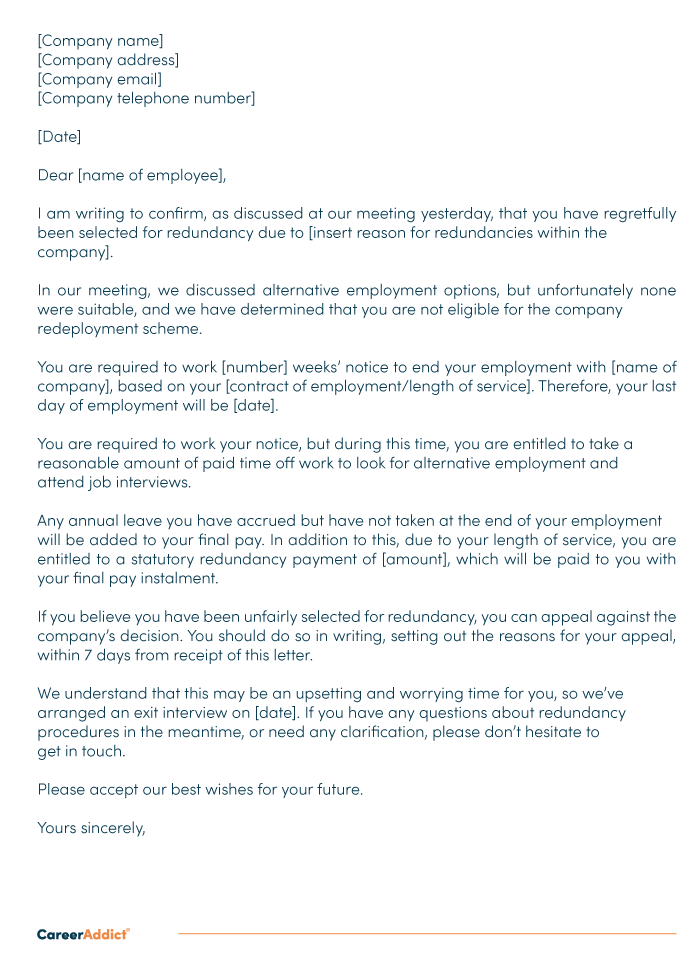Small Business Closing Employee Rights UK: What You Required to Find Out About Redundancy
Small Business Closing Employee Rights UK: What You Required to Find Out About Redundancy
Blog Article
Checking Out the Operational Characteristics of Firm Redundancy and Its Long-Term Sustainability

Redundancy Methods for Service Connection
In order to guarantee nonstop procedures, services should implement effective redundancy approaches for organization continuity. Redundancy in this context describes the replication of critical parts or features within a system to reduce the effect of possible failures. By incorporating redundancy approaches, companies can boost their strength against interruptions created by different elements such as all-natural catastrophes, tools failures, or cyber-attacks.
One common redundancy strategy is the implementation of back-up systems and data storage space services. This includes producing duplicates of important data and systems that can be triggered in case of a main system failing. Additionally, companies can develop redundant communication networks and power resources to keep connectivity and procedures throughout unanticipated events.
Furthermore, cross-training workers to carry out numerous duties within the business can serve as a valuable redundancy strategy. This guarantees that necessary jobs can still be executed even if vital employees are inaccessible because of health problem or various other reasons. In general, efficient redundancy methods are essential for organizations to promote functional connection and decrease the impact of possible disruptions.
Effect of Redundancy on Business Strength
Given the important role redundancy methods play in ensuring business connection, checking out the effect of redundancy on organizational resilience ends up being necessary for recognizing the alternative operational characteristics of a company. Business durability refers to an entity's capability to adjust to disruptions, recoup from setbacks, and transform when required while preserving core functions. Redundancy, when tactically implemented, can significantly add to enhancing an organization's durability despite unanticipated challenges. By having backup systems, personnel, or processes in position, firms can much better stand up to shocks and continue operations with marginal interruption.
Additionally, redundancy can boost worker spirits and self-confidence, understanding that there are contingency strategies in position to resolve unanticipated scenarios. This feeling of security can cause enhanced productivity and a more positive job environment. Additionally, redundancy can foster development and imagination within an organization as workers really feel encouraged to take computed risks, knowing that there is a safeguard to support them in situation of failure. Overall, the influence of redundancy on business durability is profound, forming the lasting sustainability and success of a company.
Balancing Performance and Versatility in Redundancy
Attaining an unified balance in between operational efficiency and flexible versatility is a pivotal obstacle in the strategic deployment of redundancy within organizations. Efficient operations are crucial for preserving productivity and cost-effectiveness, guaranteeing that sources are utilized ideally. However, excessive focus on effectiveness alone can result in rigidity, making it difficult for organizations to adjust to unexpected changes or difficulties. On the other hand, flexibility enables companies to react nimbly to evolving situations, cultivating development and resilience. Yet, excessive flexibility without a strong functional structure can lead to inadequacies see here and incongruity.
To balance efficiency and versatility in redundancy planning, organizations should carefully evaluate their functional demands, market characteristics, and critical objectives. Implementing lean practices can enhance efficiency by streamlining procedures and removing waste, while fostering a society of versatility and constant enhancement can improve adaptability. In addition, spending in cross-training programs and durable communication networks can assist grow a functional workforce efficient in managing diverse jobs during periods of transition. Ultimately, discovering the right stability in between performance and adaptability is critical for developing a resilient and sustainable organization in the face of uncertainty.
Long-Term Sustainability Through Redundancy Planning
To make sure enduring feasibility and security, companies must tactically align their redundancy preparation with lasting sustainability objectives, therefore integrating functional effectiveness with adaptive flexibility. Long-lasting sustainability through redundancy planning includes even more than simply short-term cost-cutting procedures. It calls for a detailed strategic technique that expects future difficulties and chances. Firms need to view redundancy not as a reactive solution to instant problems however as a positive approach for long-term success. By incorporating redundancy you can check here preparation with sustainability purposes, organizations can develop a resistant structure that can hold up against various market fluctuations and internal modifications.

Proactive Actions for Sustainable Firm Procedures
Just how can business proactively enhance their functional sustainability for long-term success? Applying proactive measures is vital for companies aiming to ensure sustainable operations.
Furthermore, cultivating a culture of continual renovation and discovering within the company can boost versatility to altering market problems and consumer needs. Urging worker involvement in decision-making processes and providing chances for specialist advancement can improve morale, productivity, and overall performance. Developing clear objectives, keeping track of vital performance signs, and routinely evaluating progression are crucial elements of aggressive sustainability administration.
Teaming up with vendors, clients, and various other stakeholders to advertise sustainable methods throughout the supply chain can develop a ripple effect of positive influence - redundancy pay if company goes bust. By taking proactive actions in the direction of functional sustainability, business can develop strength, drive advancement, and secure their long-term success in an ever-evolving service landscape
Conclusion
In the world of business administration, the strategic release of firm redundancy stands as a pivotal yet elaborate technique that demands a fragile balance between functional efficiency and long-lasting practicality. By studying the operational characteristics that underpin firm redundancy and reviewing its more comprehensive implications for business durability and flexibility, a nuanced understanding of just how redundancy methods can shape the future trajectory of a company starts to unfold.Provided the critical role redundancy approaches play in making certain organization continuity, exploring the effect of redundancy on organizational resilience comes to be crucial for understanding the alternative functional characteristics of a company. On the whole, the impact of redundancy on business resilience is profound, shaping the lasting sustainability and success of a business.
In final thought, recognizing the functional characteristics of firm redundancy is important for making sure long-term sustainability.
Report this page